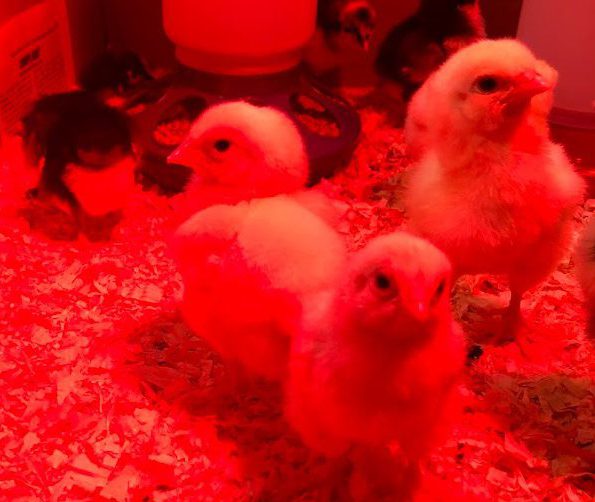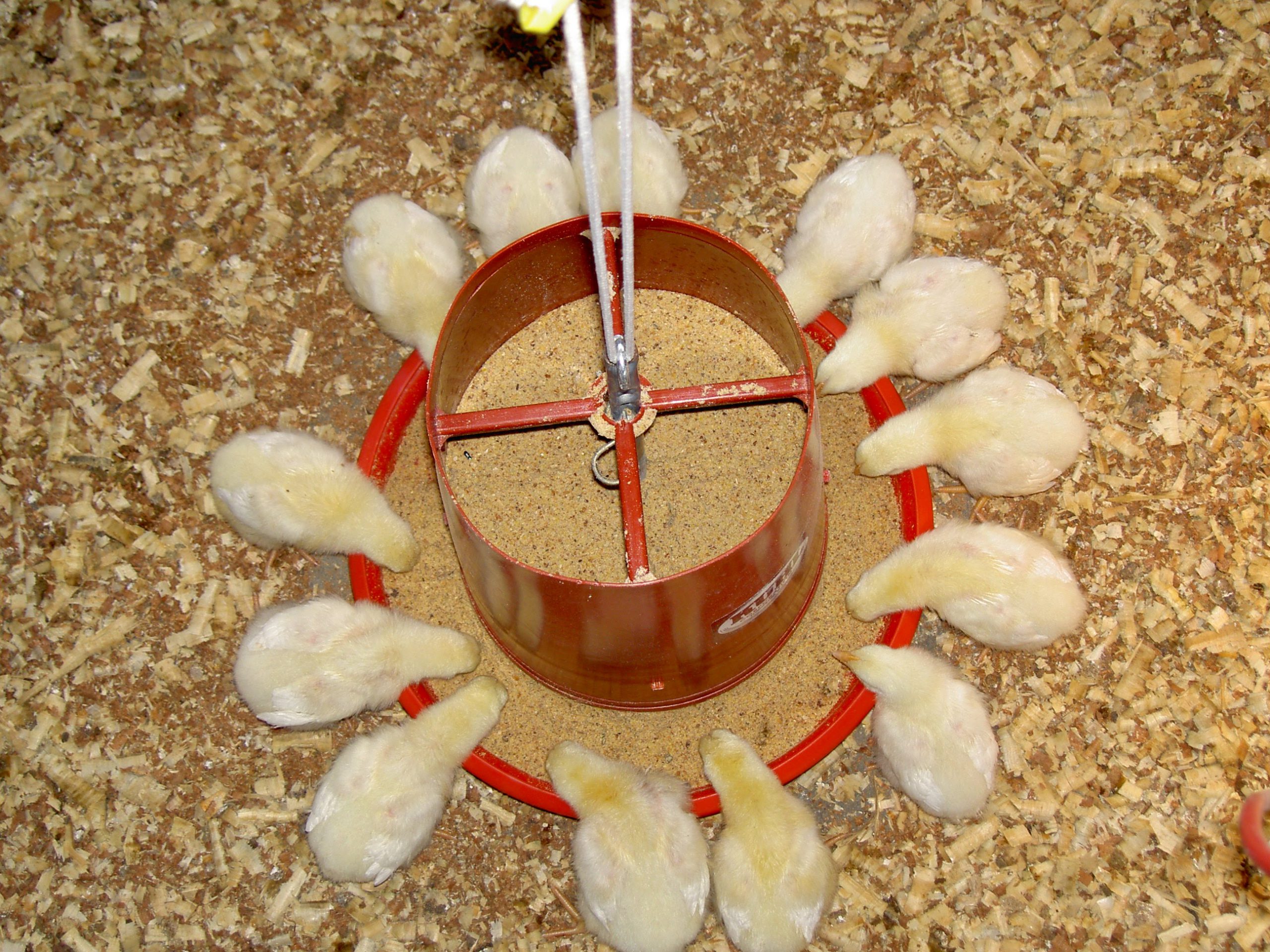Chick days are upon us, and before you take home a colony of chicks by impulse, take a moment to verify that you are ready to receive them. Below you will find some critical key points that are essential for the survival of your new feathered friends.

Regardless of their intended purpose, chicks need some essentials to properly develop into healthy productive members of our home flock. Day-old chicks we often find at the feed store are sold in small groups for a reason: they are fragile individuals. Take a moment to review if you are ready to get some from the feed store or receive them directly from the hatchery.
Brooder must-haves
An adequate brooder should have the following elements:
- Proper and constant temperature usually provided by an incandescent light.
- Solid sides
- Absorbent litter to keep the chicks dry
- Enough space for chicks to develop properly
Solid sides on a brooder are essential to block wind currents which can cause extreme fluctuations in temperature inside the brooder. Choose pine shavings, kitty litter or other absorbent material to use in the floor.

Proper square footage per chick should be provided since they will grow fast and will spend at least 3 weeks of their lives inside the brooder. Each chick will need to have 6 to 7 square inches of space inside the brooder to develop without stress. Competition for space can increase bullying and encourage pecking.
Addressing the temperature issue
Adequate temperature is one of the most important factors that affect young chicks. Due to their small body size and lack of permanent feathers, day-old chicks are not able to properly regulate their body temperature. Placing a heat lamp at the proper height will help to keep them warm and healthy. The optimal temperature for day-old chicks should be 90 – 95°F at a height of 2.5 inches from the ground to stimulate adequate conditions for chicks to roam and eat inside the brooder. To provide them with the supplemental temperature our babies need to survive, use an incandescent bulb. The typical red color you often find in these brooder lights discourages chicks from pecking their peers, reducing the social stress in their new colony.
Check the distribution of chicks inside the brooder to determine if your chicks are too warm, too cold, or adequately heated. If the chicks are huddled together in a close group, this is indicative that they are cold. To address this issue, lower the lamp gradually until they spread out evenly throughout the enclosure. Chicks that are too warm will generally stay away from the heat lamp and will be found in the corners of the brooder rather than evenly spaced. Adequate temperatures will promote an even distribution of chicks throughout the brooder.
As the chicks mature, they will need less temperature supplementation since they will grow and produce adult feathers, which are more efficient in trapping body heat. Raise the lamp so you are reducing the brooder temperature by 5 degrees per week until you can remove the lamp (when they are fully feathered). Make sure that the temperature is checked every day at least once to avoid accidental stress to these vulnerable young birds.
Meeting their nutritional needs

Young chicks need significantly different feed than laying hens and older birds. Starter-grower feed is higher in protein and minerals than adult formulations. The nutritional requirements during the first growing phases of the chick’s lives require 20-22 percent protein during the first 6 weeks of their lives. From week 7 to 14 the protein requirement drops to 16-18, and from 14 to 20 weeks in age, it drops further to 14- 19 percent. Energy requirements stay relatively similar from day 0 to laying at 1290 to 1315 kilocalories per pound of feed, while calcium needs increase dramatically when the birds mature and start laying.
Check your feed tags and make sure that chicks get a high protein, low calcium diet until they start laying eggs. Feed storage is another critical aspect of raising healthy chicks, which often gets overlooked by backyard flock owners. Store feed in a rodent-proof container, since these pests can carry diseases that can affect our young birds. Also, avoid moldy feed since mold can cause respiratory issues as well as toxins that will make our chicks sick.
For further information, please contact our office and we can provide further guidance.
Transitioning your young birds
After approximately three weeks of age your chicks should be fully feathered and can be transitioned into cages or runs. Young birds should never be mixed with their adult counterparts. Keep your youngsters separated, but with some contact with the rest of your colony for several weeks if this is an option.

There is a practice called “all in-all-out”, which applies to poultry production at all levels. This term refers to the action of avoiding mixing flocks for health reasons. Avoid comingling birds from neighboring properties to reduce the chance of contracting diseases. Also, avoid the contact with wild waterfowl since they carry many infectious diseases that can be harmful to your home flock and even to humans.
Finally, contain your birds in predator-proof environments where they can enjoy a healthy, productive life.
Contact us for more information!
If you have further questions on raising backyard poultry, please contact us at the UF/IFAS Extension Hardee County office by calling 863-773-2164 or stopping by at 507 Civic Center Drive, Wauchula FL 33873. We are here to provide you with educational resources that can improve your agricultural venture or operation.
Further Reading:
- Preparándonos para recibir los pollitos – UF/IFAS Extension Hardee County (ufl.edu)
- Coccidiosis in Backyard Chickens – UF/IFAS Extension Polk County (ufl.edu)
- Coccidiosis en Pollos de Traspatio – UF/IFAS Extension Polk County (ufl.edu)
- AN-170/AN182: Care of Baby Chicks (ufl.edu)
- AN239/AN239: Raising Backyard Chickens for Eggs (ufl.edu)
 0
0

Comments:
March 8, 2022
During the time they require the brooder they do not need a run. Constant temperature and protection from drafts is the most critical part for their development at this point.
February 18, 2022
Thank you for this! I am in the process of obtaining my first little backyard flock and am feeling a bit intimidated by this whole brooder issue. This really helped me feel more confident! I have a coop set up and ready, but also wanted to provide a run. Do these have to be connected? Can I train the birds to go into it and then back to the coop at night? Thank you for your help.
December 14, 2020
Not that I am aware. Maybe watch weather pattern differences because these can affect the germination time.
December 13, 2020
any special requirements or things to be extra aware of in zone 9B-10, im right on the cusp?
November 10, 2020
Corto y conciso, francamente maravilloso el post. Mas que nada porque para mi, familiarizarse con los requerimientos particulares de cada animal es sin dudas lo mas esencial en la cría.
March 29, 2019
Saludos: espero estar traduciendo todos mis "blogs" para el beneficio de todos! Gracias
March 29, 2019
Me da gusto que este post este en espanol espero que sigan poniendo mas
August 9, 2018
UF has also released flies to manage fire ants. Bottom line: there is nothing more effective right now than chemical control right now.
July 25, 2018
University of Texas are studying agricultural control of fire ants with a species of phorid flies. Is this something we are trying in Florida as well? Fire ant mounds are very difficult to control and they can easily take over a yard. I have tried several different product without any good results. I am trying some products by Amdro, Siege, and Extinguish next. If there were any better natural products available I would much rather use than spreading chemicals.
March 9, 2018
I was thinking it would be fun to have a food plot for the local wildlife. It makes sense that a good location would be important! I'll be sure to find a place that deer have access to.
August 10, 2017
Well done, Marissa.
August 10, 2017
Great article, Marissa.
August 3, 2017
Hello, the whole thing is going sound here and ofcourse every one is sharing information, that's genuinely good, keep up writing.
August 1, 2017
Greetings from California! I'm bored at work so I decided to check out your site on my iphone during lunch break. I love the info you provide here and can't wait to take a look when I get home. I'm surprised at how quick your blog loaded on my phone .. I'm not even using WIFI, just 3G .. Anyways, excellent site!
July 21, 2017
This is a terrific program. These students are so fortunate to get this information in such a fun way. Thanks to all the adults who shared their time and knowledge.
July 21, 2017
What a great article!
July 20, 2017
I really enjoy the blog article. Really Great.
July 15, 2017
Thanks foor ones marvelous posting! I certainly eenjoyed reading it, you may be a great author.I will make certain to bookmark your blog and will come back very soon. I wannt too encourage you to definitely continue your great work, have a nice evening!
July 15, 2017
Howdy! I could have sworn I've been to your blog before but after going through many of the articles I realized it's new to me. Nonetheless, I'm certainly pleased I came across it and I'll be book-marking it and checking back frequently!
July 15, 2017
Just desire to say your article is as astonishing. The clarity in your submit is simply great and that i could think you're a professional in this subject. Well along with your permission allow me to take hold of your feed to stay up to date with forthcoming post. Thank you 1,000,000 and please carry on the enjoyable work.
July 10, 2017
fKXhHg Major thanks for the blog.Thanks Again. Much obliged.
July 6, 2017
It's actually a great and helpful piece of information. I'm satisfied that you just shared this helpful information with us. Please keep us informed like this. Thank you for sharing.
July 4, 2017
Thanks, it is quite informative
May 12, 2017
My brother recommended I might like this web site. He was entirely right. This post truly made my day. You cann't believe simply how much time I had spent for this information! Thanks!
April 28, 2017
I'm not sure where you're getting your info, but good topic. I needs to spend some time learning more or understanding more. Thanks for fantastic information I was looking for this information for my mission.
April 28, 2017
Please do share it with others. You can post it on social media too. This is public information.
April 28, 2017
Hey! Would you mind if I share your blog with my zynga group? There's a lot of folks that I think would really appreciate your content. Please let me know. Thanks
Comments are closed.